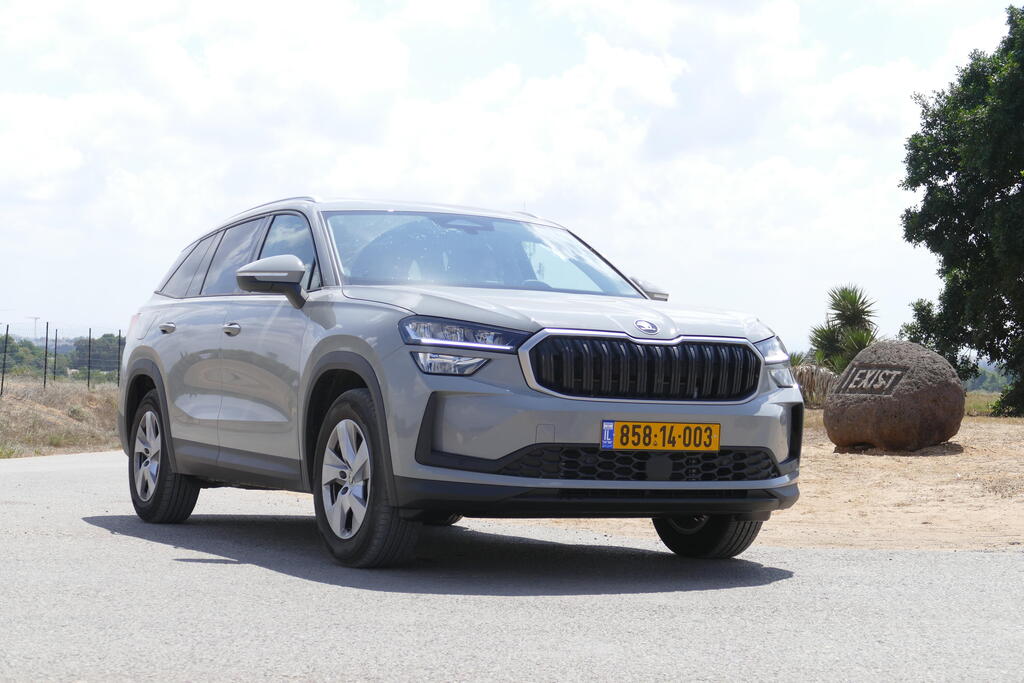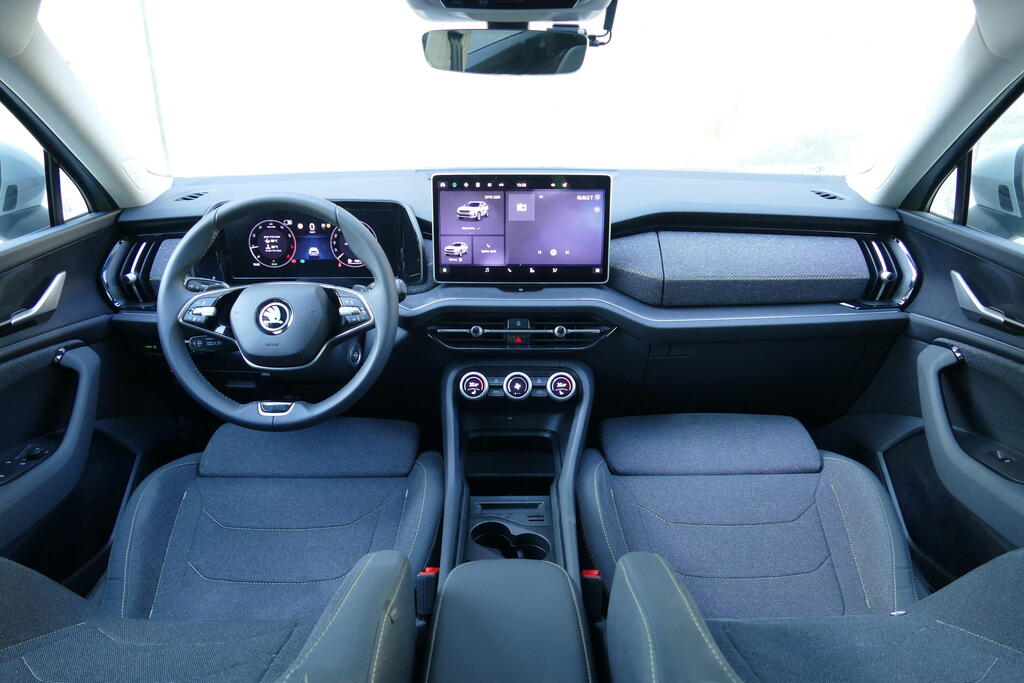The Kodiaq isn’t Skoda's first rodeo in the SUV arena; that honor goes to the quirky Yeti. But the Kodiaq is the model that truly propelled Skoda into the competitive seven-seater SUV market, a category that's largely taken over from the compact minivans.
It did this by combining the superb base of the Superb with a longer body and a third row of seats, along with clever and original solutions. This formula turned it into a serial winner in every comparison test it entered.
Now, a new generation has landed, promising to keep the familiar recipe with the same platform and powertrain but improvements in every other aspect. Sounds very promising.
Summary: The new Kodiaq retains a significant resemblance to the outgoing model, which has its pros and cons. On the plus side, it still offers a practical and spacious cabin, a relatively large trunk, good overall ride quality, and satisfactory performance. But it seems that, like Volkswagen, Skoda has also fallen victim to pouring vast resources into developing electric models at the expense of neglecting well-known and successful core models.
- Direct competitors: Mitsubishi Outlander, Nissan X-Trail, Peugeot 5008
- Good: Living space, trunk
- Okay: Ride comfort, dynamic capability, fuel consumption
- Needs improvement: Performance, equipment
- Rating: 7
In the case of the Kodiaq, this is particularly noticeable, as it resembles its predecessor too closely and may struggle to convince loyal customers to upgrade to the new model. It also uses the same old power unit, which now feels outdated. What's more important, it currently offers a less-equipped specification, giving up many of the practical ideas that made it so desirable among large families.
This means maintaining its position at the top of the category against direct competitors and electric alternatives is not guaranteed at all.
Appearance: The exterior design has been slightly updated for the better, mainly thanks to new lighting units and bumpers. Skoda also claims to have reduced the drag coefficient (0.28 compared to 0.31). However, overall, the vehicle is less impressive than before, partly due to modest wheels (17 inches) that resemble plastic covers.
The driver’s environment has undergone a significant update, with modern graphics for the digital dashboard (10.25 inches) and a larger, higher-quality touchscreen (13 inches compared to 8 inches previously). Unlike the norm in Volkswagen, Skoda has retained three multifunctional dials here for controlling climate and sound volume, making operation more convenient and intuitive. The gear selector is positioned to the right of the steering wheel, freeing up space for a large storage compartment between the driver and passenger, with a pair of charging pads. The air vents, however, are located lower than before, making it difficult to efficiently cool the cabin.
The front seats offer plenty of adjustment and support options, allowing for prolonged sitting without effort, with a high driving position and excellent visibility. Material quality is relatively good, but extensive use of black creates a gloomy feeling, while the carbon trim is unnecessary.
The wheelbase is identical to the outgoing Kodiaq (9.1 feet) with similar living space for second-row passengers, and the ability to slide the bench forwards and backwards. It is 6 cm longer than before (476 cm), thus offering slightly better living space for children in the third row. The trunk has increased by 56 liters when all seats are in use (289 liters), and by 201 liters with the third row folded (794 liters). It still comes with a temporary spare wheel.
On the downside, it is disappointing to discover that many smart features did not make their way to the new generation. Missing items include sunshades for the rear windows, retractable rubber strips on door edges to prevent parking damage, and headrests with a smart mechanism supporting the head on long journeys. The comfort equipment list is modest, lacking a smart key, with manual adjustment for the front seats, manual trunk opening, and a simple rearview camera. However, there is a large sunroof.
Advanced safety systems now include lane-keeping (previously correction) and door-opening warning, in addition to autonomous braking, adaptive cruise control, and blind-spot warning offered before. However, the number of airbags is fewer than in Europe (7 compared to 9).
How it drives: The advanced plug-in hybrid powertrain, with a zero-emission range of over 60 miles, will not be marketed here since the battery's location eliminates the possibility of a third row of seats. The engines offered here are inherited from the previous model: a 2.0-liter 4-cylinder turbo-diesel in two power levels (150 or 193 hp) or a 1.5-liter turbocharged gasoline engine (150 hp) like in the test vehicle. It is connected to a mild hybrid system (48V) and is expected to be the most popular in the range.
It is linked to a 7-speed dual-clutch transmission with uneven operation in urban driving, and relatively slow responses. These affect the performance during standing starts (9.9 seconds, 0.1 seconds longer than before) and mainly in mid-range acceleration simulating overtaking.
The powertrain struggles under the load of four adults and three children on board on a mountainous road. Additionally, at low load, the engine shuts off every time you lift off the accelerator, and without a driving mode selector, this function cannot be deactivated. Fuel consumption was relatively good—7.7 miles per liter on average in the test.
As mentioned, the platform (MQB) and suspension setup (MacPherson front and multi-link rear) remain unchanged. Surprisingly, despite the small wheels, urban ride comfort is not stellar, being overly stiff on bumpy asphalt. Noise insulation is relatively good.
The vehicle's handling is safe and good relative to its type, while the steering has a natural weight but the brakes lack feel at the start of the pedal travel.
- Engine: Turbo-petrol, 4 cylinders, 1.5 liters
- Power: 150 hp at 6,000 rpm
- Torque: 184.5 lb-ft at 1,500 rpm
- Transmission: 7-speed dual-clutch, front-wheel drive
- Length: 187.3 inches
- Width: 73.4 inches
- Height: 66.1 inches
- Wheelbase: 109.9 inches
- Kerb weight: 3,825 pounds
- Trunk volume, third row folded: 10.2 cubic feet, 28.0 cubic feet
- 0-62 mph, top speed: 9.9 seconds, 127 mph
- Fuel consumption, emissions: 38.6 mpg, 225 grams CO2 per mile
- Airbags: 7
- Safety rating (Euro NCAP): Five stars
- Price: Approximately $56,600 USD



